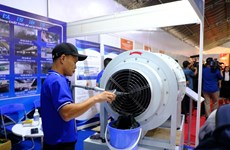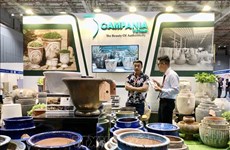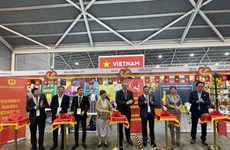Sea-island economy - a strong sovereignty marker
A robust sea-island economy will be a strong sovereignty marker, Nguyen
Chu Hoi, former General Director of the Vietnam Administration of Seas
and Islands, tells the Econet magazine.
A robust sea-island economy will be a strong sovereignty marker, Nguyen
Chu Hoi, former General Director of the Vietnam Administration of Seas
and Islands, tells the Econet magazine.
* As a dedicated researcher of the formation and application of Government policy on the nation's seas and islands, please give us an overview of our East Sea resources?
The East Sea (internationally known as South China Sea) contains marine natural resources important for daily life and economic development of the nations surrounding it, including seafood and minerals.
It is the one of the world's top ten marine bio-diversity spots and one of the world's 16 biggest fishing areas that have for long been the traditional fishing grounds of Vietnamese fishermen. It is also an area favourable for aquaculture development.
Besides its natural resources, the East Sea boasts the world's busiest maritime route, connecting the Indian Ocean with the Pacific Ocean. There are between five and seven regional sea lanes there.
Furthermore, with its long coastline and multiple estuaries, lagoons, gulfs and bays, Vietnam has great potential to develop its ports and harbours.
The East Sea's rich natural resources and its position of "a crossroads" on the world maritime map reflects its great geo-political value, for the region and the world, tempting all nations in the region and outside to claim sovereignty over the islands and sea areas.
With nearly 3,000 islands and islets near the continental shore and other archipelagoes far offshore, Vietnam has great potential to develop its island economy. Each island should act like a "sovereignty marker" and "undefeatable battleship". Many islands with favourable geological traits can be developed into economic centres providing fishing and shipping services.
Around the Truong Sa (Spratly) Archipelago, there are nearly one million hectares of shallow lagoons 1-6m deep, surrounded by atolls (ring-shaped coral reef), making them suitable for aquaculture. Marine life diversity is high there. For instance, 517 coral species have been found in the area.
Besides the value of fishing services and aquaculture, many islands also have appealing scenery and diverse ecological systems suitable for developing eco-tourism services. On the islands are the traditional fishing villages with age-old cultural and religious structures as also the cultural traditions of island fishermen, reflecting their long history of living with and off the sea. The tourism benefits of these values have not been tapped.
* So how have we exploited such great resources and old seagoing traditions so far?
For thousands of years, the sea has been a source of livelihood for millions of Vietnamese citizens, contributing to national development and creating unique identities, lifestyles and relationships with the sea. However, we have not yet formed a sea industry in its real meaning, despite having a Government policy in place. We have the policy, but we do not have specific regulations and standards for building such an industry, causing confusion when it comes to implementing the policy. Our emphasis thus far has been on coastal development, not deep sea development. We should be prepared to go out to the deep sea today for our tomorrow. We need to set targets and draw up a roadmap that sets out the specific steps we have to take in reaching them. Of course, there should also be criteria for assessing implementation of the plan at various stages.
Across-the-board development of the sea economy is a costly project that will yield long-term returns. This means that we need people with decisive, risk-taking attitudes. Short-term investments or people with short-term visions will never succeed.
* Effective and reasonable use of marine resources has been a stated national development strategy. How do you assess its implementation thus far?
To support development of the island economy, it is necessary to establish and maintain a strong link between islands and the shore, particularly coastal areas. There have been good practices around the world and even in colonial Vietnam (under the French) that developed a chain of cities along the coast. We can see it as a port-urban residential area-coastal economic zone-sea model. The four components of this model are separate economic sectors that are connected, supporting comprehensive development for long-term benefits.
Current Government policy is now focused on developing cities in alignment with deep-water ports on the central coast.
This policy is right, strategic and suitable, given the country's specific conditions. It has also accommodated the good practices mentioned above. The development of coastal cities and economic zones near deep-water ports will enhance the role of central Vietnam in boosting the nation's sea and island economy.
However, this development will have to match the nation's plan for green economy development in the 2014-2020 period. This means that the "brown" sea economy based on oil production will have to gradually move to a "green" sea economy based on marine and island tourism. New jobs will be created for coastal and island dwellers.
Together with the development of sea economy, developing the island economy in a robust, effective and sustainable manner will help assert the real and permanent sovereignty over the seas and islands Vietnam claims. It is the best way to show Vietnam's jurisdiction in the concerned sea area.-VNA
* As a dedicated researcher of the formation and application of Government policy on the nation's seas and islands, please give us an overview of our East Sea resources?
The East Sea (internationally known as South China Sea) contains marine natural resources important for daily life and economic development of the nations surrounding it, including seafood and minerals.
It is the one of the world's top ten marine bio-diversity spots and one of the world's 16 biggest fishing areas that have for long been the traditional fishing grounds of Vietnamese fishermen. It is also an area favourable for aquaculture development.
Besides its natural resources, the East Sea boasts the world's busiest maritime route, connecting the Indian Ocean with the Pacific Ocean. There are between five and seven regional sea lanes there.
Furthermore, with its long coastline and multiple estuaries, lagoons, gulfs and bays, Vietnam has great potential to develop its ports and harbours.
The East Sea's rich natural resources and its position of "a crossroads" on the world maritime map reflects its great geo-political value, for the region and the world, tempting all nations in the region and outside to claim sovereignty over the islands and sea areas.
With nearly 3,000 islands and islets near the continental shore and other archipelagoes far offshore, Vietnam has great potential to develop its island economy. Each island should act like a "sovereignty marker" and "undefeatable battleship". Many islands with favourable geological traits can be developed into economic centres providing fishing and shipping services.
Around the Truong Sa (Spratly) Archipelago, there are nearly one million hectares of shallow lagoons 1-6m deep, surrounded by atolls (ring-shaped coral reef), making them suitable for aquaculture. Marine life diversity is high there. For instance, 517 coral species have been found in the area.
Besides the value of fishing services and aquaculture, many islands also have appealing scenery and diverse ecological systems suitable for developing eco-tourism services. On the islands are the traditional fishing villages with age-old cultural and religious structures as also the cultural traditions of island fishermen, reflecting their long history of living with and off the sea. The tourism benefits of these values have not been tapped.
* So how have we exploited such great resources and old seagoing traditions so far?
For thousands of years, the sea has been a source of livelihood for millions of Vietnamese citizens, contributing to national development and creating unique identities, lifestyles and relationships with the sea. However, we have not yet formed a sea industry in its real meaning, despite having a Government policy in place. We have the policy, but we do not have specific regulations and standards for building such an industry, causing confusion when it comes to implementing the policy. Our emphasis thus far has been on coastal development, not deep sea development. We should be prepared to go out to the deep sea today for our tomorrow. We need to set targets and draw up a roadmap that sets out the specific steps we have to take in reaching them. Of course, there should also be criteria for assessing implementation of the plan at various stages.
Across-the-board development of the sea economy is a costly project that will yield long-term returns. This means that we need people with decisive, risk-taking attitudes. Short-term investments or people with short-term visions will never succeed.
* Effective and reasonable use of marine resources has been a stated national development strategy. How do you assess its implementation thus far?
To support development of the island economy, it is necessary to establish and maintain a strong link between islands and the shore, particularly coastal areas. There have been good practices around the world and even in colonial Vietnam (under the French) that developed a chain of cities along the coast. We can see it as a port-urban residential area-coastal economic zone-sea model. The four components of this model are separate economic sectors that are connected, supporting comprehensive development for long-term benefits.
Current Government policy is now focused on developing cities in alignment with deep-water ports on the central coast.
This policy is right, strategic and suitable, given the country's specific conditions. It has also accommodated the good practices mentioned above. The development of coastal cities and economic zones near deep-water ports will enhance the role of central Vietnam in boosting the nation's sea and island economy.
However, this development will have to match the nation's plan for green economy development in the 2014-2020 period. This means that the "brown" sea economy based on oil production will have to gradually move to a "green" sea economy based on marine and island tourism. New jobs will be created for coastal and island dwellers.
Together with the development of sea economy, developing the island economy in a robust, effective and sustainable manner will help assert the real and permanent sovereignty over the seas and islands Vietnam claims. It is the best way to show Vietnam's jurisdiction in the concerned sea area.-VNA













